Travel Through The United States of America on a Harley-Davidson
By Peter & Kay Forwood
The United States of America on a Harley (4/6/03 - 13/9/03)
Distance 26145 km (331547 km to 357692 km)
This is part of the ninth section of our around the
world trip.
Complete Trip Overview & Map
Coming from Cuba or read our previous visit
to U.S.A.
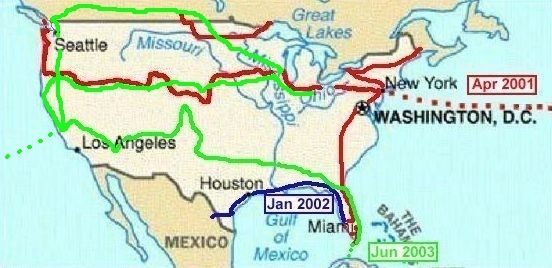 4/6/03 We were at the Key West marina fuel dock by 7 am
and with a series of Agriculture, Immigration and Customs officials were
cleared by 9 am. The boat has a special permit to do mission work in Cuba
and as such the crew had no problems on returning to the USA. Being Australians
coming from Cuba we also were not subject to the US restrictions however had
we departed to Cuba from the USA and were now returning we would have been
subject to US laws regarding the embargo. We made a donation to the mission,
equal to what others had told us was the usual charge for the passage, and
said goodbye. The total cost for the crossing including Cuban paperwork being
about $US 400.00, no costs to enter the US. If you want to contribute to
the mission's work or find out more about what they do, the captain, Keith,
can be contacted by email on R5CaptainK@aol.com. A fork lift unloaded the
motorcycle from the boat's deck and we rode to the southernmost beacon in
the USA. It was 19 months ago when we left the beacon to do the loop through
Central, to South America and up the Caribbean, and great to return. Headed
up the coast to recover and regroup, at a cheap motel.
4/6/03 We were at the Key West marina fuel dock by 7 am
and with a series of Agriculture, Immigration and Customs officials were
cleared by 9 am. The boat has a special permit to do mission work in Cuba
and as such the crew had no problems on returning to the USA. Being Australians
coming from Cuba we also were not subject to the US restrictions however had
we departed to Cuba from the USA and were now returning we would have been
subject to US laws regarding the embargo. We made a donation to the mission,
equal to what others had told us was the usual charge for the passage, and
said goodbye. The total cost for the crossing including Cuban paperwork being
about $US 400.00, no costs to enter the US. If you want to contribute to
the mission's work or find out more about what they do, the captain, Keith,
can be contacted by email on R5CaptainK@aol.com. A fork lift unloaded the
motorcycle from the boat's deck and we rode to the southernmost beacon in
the USA. It was 19 months ago when we left the beacon to do the loop through
Central, to South America and up the Caribbean, and great to return. Headed
up the coast to recover and regroup, at a cheap motel.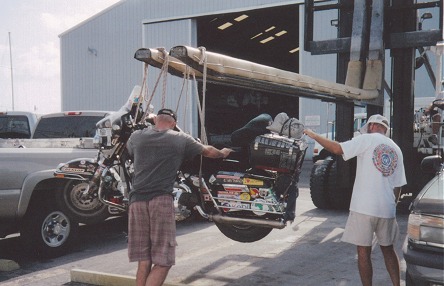
5/6/03 Inundated by choice and billboards again. We have
not seen a billboard (other than political) in the last three weeks and
selection of goods has been extremely limited. But it is as difficult to
wade through the unfamiliar systems here. Like needing a specific discount
card to get the discounts in the supermarket or a payment card in the laundromat
to use the machines or having to prepay for petrol. Havana was the only place
in Cuba with traffic lights and we have already been stopped by more lights
here than exist in the whole of Cuba. Yes we can buy anything but it is miles
between the bookshop, the laundromat and the library instead of a short walk.
Both places are as extreme as each other, at each end of where we like to
be, somewhere in the middle. Regrouped with guide book and maps planning the
next three months of travel.
6/6/03 Rode onto Ft Lauderdale H-D and bought a new regulator,
fitted it but didn't solve the electrical problem and with the battery slowly
getting weaker continued on to Daytona Beach where we intended to stay a few
days. After tests at the H-D dealer they were convinced the problem is an
intermittent alternator (stator rotor) shorting out. With labour costs at
$US 70.00 an hour we decided to buy and try fitting the alternator ourselves,
tomorrow.
7/6/03 Rain outside and Kay's stomach still upset, probably
from Cuba, aggravated by the rough boat crossing we stayed in our hotel
room almost all day, work on the motorcycle tomorrow.
8/6/03 Replaced the alternator early morning in the hotel
car park before most of the inhabitants got out of bed. About two and a
half hours. It was easy to see that it was the problem, with the plastic
insulation cracked exposing bare wires. Relaxed then walking along endless
miles of Daytona Beach, one of the few that allow motorized vehicles to drive
on. The weekend holiday makers were out grabbing the sunshine before afternoon
thunderstorms. There are always H-D's riding the streets in Daytona, their
owners drinking in the bars on Main St or just doing that great American
pastime, shopping for something they don't need but wouldn't it look great
on the motorcycle.
9/6/03 Things in the USA are expensive if they involve
labour but other things are free, or cheap. Internet at libraries free,
telephone calls cheap. Changed oils on the motorcycle. The isolation and
spreadoutness of Americans makes casual meaningful encounters difficult.
Born into two generation homes, isolated from the weather and others in motor
vehicles, entertained in their homes by TV, trained to be competitive and
work efficiently, casual interaction with others moving in their environment
is rare. Unlike where we have just come from the streets don't throng with
people, here they drive from one mega store to the next. There is rarely
anyone on the corner to ask directions. People will look at the motorcycle
from a distance, personal space expansive, not wanting to disturb us they
leave questions unasked therefore unanswered. The sudden difference from
the Latin American upfrontness and openness a little off-putting.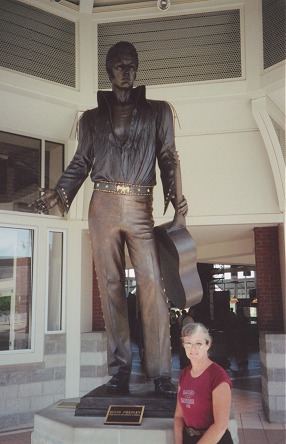
10/6/03 The second biggest American pastime, after shopping
seems to be driving, interstates, packed with cars and trucks, moving at
115 km/hr (70 mph), down tree lined roads, segregated from the non travelling
America. Switching to a red road in Georgia, we continued to Alabama, through
some smaller towns and sat on a porch chewing the fat with a couple of southern
folks in rocking chairs while they had time off from working in the pecan
nut orchards. This poorer part of the USA houses its people in mainly prefabricated
houses delivered complete to the site. A cheap motel for the night, now affordable
since the US dollar is slipping in value and our Australian dollar is rising
giving us 25% more buying power than when we were here two years ago.
11/6/03 Crossed Mississippi and onto Memphis Tennessee,
camping 10 miles south of town. Its hard to get away from mechanical noises.
On long sections we wear ear plugs to dampen wind, tyre and truck noises
but even at our campground all night there are aeroplanes, pumps, distant
road noise or air conditioners and fans in motels. Something we all accept
with progress but its amazingly quiet when finally there are only animal
or wind noises, if you can still find such a place. The solitude of sailing,
in an underground cave, sitting on a remote beach with the waves drowning
other sounds or walking all day into the mountains the few refuges left.
12/6/03 The logistics of independent travel take up enormous
amounts of time, probably more than the sightseeing. Keeping the motorcycle
running, reading guide books, studying maps, buying food, cooking and camping.
Plus the riding between destinations leave the short snippets of history,
culture and people gems in the day. Sometimes just the logistics are enough.
We didn't leave our quiet wooded campground all day. Watched holiday makers
rush in and out, taking kids here and there, restaurants for breakfast,
lunch and dinner, cramming life into the one or two week summer holidays.
13/6/03 Sun studios saw the start of it all in the 1950's,
the start of Rock and Roll, which led to the freeing up of the baby boom
generation, flower power of drugs and open sex. The fears of parents were
correct when Elvis shook his pelvis on stage, the youth previously held in
close by religion broke free demanding real freedom, equality and civil rights.
The recording studio recorded people like Howlin Wolf, B B King, Ike Turner,
Jerry Lee Lewis, Elvis Presley, Roy Orbison, Johnny Cash and many more, all
here in Memphis. Beale St is still the centre, changed, modified and memorabiliaified,
bands still come to play in the streets for tips like tonight's Big Jerry
band from Arkansas playing its version of the Blues. Two blocks of the city
are closed to traffic and opened to the public to wander, drink in hand, from
one band or venue to the next with more than twenty live entertainment venues.
After watching the imitation paddle steamers run tourists on the Mississippi,
stroll the empty city streets in daylight, it was great to sit in the gutter
with the mix of blacks and whites, drinking beer and listening to black and
white bands of blues and 60's music in the vibrant Beale St.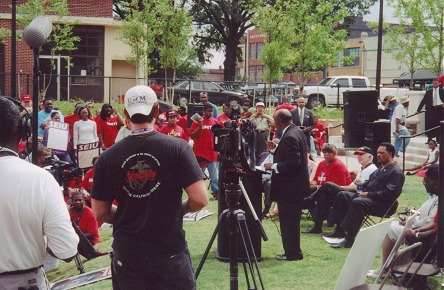
14/6/03 Memphis was also one of the Southern cities troubled
by the Civil Rights Movement of the 1960's. 100 years since the blacks had
won their freedom in a civil war and yet over half of the US states still
had segregation in one form or another in schools, restaurants, toilets,
buses and rules made it difficult for them to vote. At the small Lorraine
Hotel downtown in April 1968, Martin Luther King was gunned down and killed.
Amidst controversy over government involvement or prior knowledge of the
event no clear understanding has come to light. The motel is now the National
Civil Rights Museum where we spent three hours learning in an unbiased factual
account of events leading up to today's integration of black people into American
society. Today there was a labour demonstration, mostly black workers fighting
white management for better pay and safer working conditions, guest speaker,
the Reverend Jessie Jackson, who 35 years ago was at Martin Luther King's
side when he was shot dead at this same site during a labour dispute over
similar issues. Back to Beale St for the evening and spent most of our time
entertained by a captivating female vocalist, a cross between Joe Cocker and
Janis Joplin.
15/6/03 Middle aged parents drag along their children
to re-live the Elvis dream at Gracelands, his home and resting place. The
mans inability to live up to his own image in life had to die so the fans
could keep the larger than life worship going. The American quest for theme
parks and memorabilia encourages the faithful. We watched crowds line up
for tickets then line up for buses to his former house before buying the
souvenirs and bragging rights of worshiping the man. This scene more than
compensated us for not spending the US $25.00 each for the complete Elvis
tour. There are about 500 churches in the Memphis bible belt each preaching
their own version of worship. The Reverend Al Green has met the competition
for patrons and offerings by having a lively service that would make Whoopie
Goldberg's "Sister Act" look tame. The Full Gospel Tabernacle Choir pumps
out spiritual songs backed by a four piece band of drums and guitars making
this church rock. The voices of the black singers matched to the enthusiastic
preacher's sermon of encouragement rather than fire and brimstone, a bit
of a shock to someone brought up on Protestant conservative teachings. A
social gathering of comings and goings, we left the 2.5 hour service early
feeling drained of energy.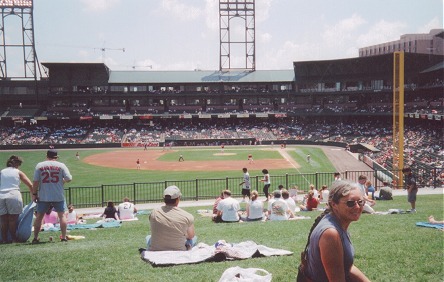 Being father's day and the traditional taking of dad to the ball game,
we went along to a new stadium bringing baseball back to inner cities. The
game seemed to take second fiddle to social activities with half the spectators
out of their seats at any one time, many down side-show alley, pitching, climbing,
rides, and the biggest event of all the feeding frenzy. I could not believe
the quantities of nachos, hot dogs, ice creams, coca cola, and the one use
packaging garbage generated by this pastime. The result of 4 to 3, Cubs to
Redbirds seemed of little interest, two home runs. Most excitement was generated
when the ball lobbed into the crowd, held aloft by the captor.
Being father's day and the traditional taking of dad to the ball game,
we went along to a new stadium bringing baseball back to inner cities. The
game seemed to take second fiddle to social activities with half the spectators
out of their seats at any one time, many down side-show alley, pitching, climbing,
rides, and the biggest event of all the feeding frenzy. I could not believe
the quantities of nachos, hot dogs, ice creams, coca cola, and the one use
packaging garbage generated by this pastime. The result of 4 to 3, Cubs to
Redbirds seemed of little interest, two home runs. Most excitement was generated
when the ball lobbed into the crowd, held aloft by the captor.
16/6/03 100 years ago yesterday, Henry Ford started his
motor company, cars for the working man, production line assembly. But he
could not have foreseen the change to the American landscape that would follow.
4 million miles of sealed roads with flyovers on flyovers. Over 40,000 people
each year dying in road accidents, a quarter of the world's fuel being used
in this country, people spending more time with their motor vehicle than their
families. The road has come to own many of us. We rode 600 km, mostly wet
from drizzle, to a cheap hotel in the middle of nowhere in Oklahoma.
17/6/03 The "Main Street of America", Route 66, crossed
from Chicago to Los Angeles, almost 4000 km's, through eight states. Officially
beginning in 1926 it became famous for adventure and freedom in the 50's
and 60's. Almost all of the road has been covered up, side tracked or bypassed
but the section through Oklahoma state still links small towns. We joined
the road at Tulsa and onto Oklahoma city, lunching at the Rock Cafe, turning
out burgers for decades.
18/6/03 Dunlop had two tyres waiting for us at Harley
World and we fitted them and greased the wheel bearings. About a month ago
an internet reader of our site invited us to dinner in Oklahoma, last night,
and from that contact we learnt of the Wednesday get together of 300-400
motorcycles at Joe's Crab Shack. What had started three years ago as a small
group of riders grew rapidly, the cheap beer helped. All brands of motorcycle,
dominated by Harleys, people showing off their latest modifications, meeting
friends or travellers. The motorcycle gained a couple more stickers and us
souvenir T-shirts.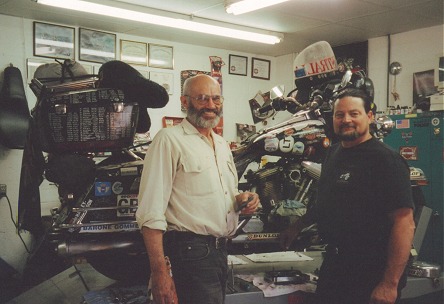
19/6/03 Ray and Jessica Acker of Ray's Custom Cycles spotted
our motorcycle's rocker box cover oil leak at Joe's last night and offered
a free bench, tools and help in solving the problem. This morning, working
together, we replaced the broken gasket, and fixed the oil leak. Ray has
been working out of his garage for a few years and is moving to a shop front
next weekend. There are many such shops in the US, often working on older
Harleys, generic brands or doing custom work that the H-D dealers don't tend
to do, nor want to do. However with the high cost of labour, often $US70
an hour at the Harley dealers and the isolated, regimented workshops they
often have, some owners are turning to the more personal owner run custom
shops, particularly if their motorcycle is a few years old.
20/6/03 There are some great museums in the USA. Funded
by corporate and generous personal donations the National Cowboy and Western
Heritage Museum covers the history of the cowboy, both the real and the
big screen version. It covers western art, weapons, the cavalry and has a
full model town. A good few hours spent here before the 8th Annual Blues
Festival in redeveloped Bricktown. Two days of local bands play in a downtown
carpark.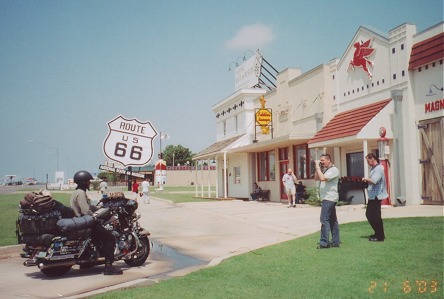
21/6/03 The I-40 runs parallel or merged with the old
Route 66 right across this section of the USA. Many small towns failed to
survive being by-passed. Others create museums to the road or get involved
in the nostalgia. Left Oklahoma state, traversed Texas and slept in New Mexico.
22/6/03 New Mexico, the 47th state, is a newer addition
and still has a Mexican frontier feel. Large areas of land are owned by
the Indian Nations, sort of independent they are allowed to run casinos.
They also do a roaring trade in Indian (made in China or Pakistan) artefacts.
You can visit many pueblos (villages), open to the public, free or for a
fee, but most of the adobe houses are mud coloured concrete built in the
traditional thick walled flat roofed design. Los Alamos, where the first
nuclear weapon was built under enormous secrecy in the second world war,
has a great science museum showing the past and present research at the city.
Just to the south is where over 1000 nuclear bombs were exploded in tests
before they were banned in 1992. We camped in a forest reserve in the cool
high mountains.
23/6/03 Out of the forests heading NW on the 550 through
many different indian reservations. Crossed the continental divide, oil
change, internet, enroute to Durango for groceries and on to Mesa Verde National
Park to camp. Into the holiday areas and holiday season we are surprised how
many same sex couples or groups are travelling together and how few families.
Men on motorcycles or RV's, fishing, women with children camping, where if
anywhere are spouses.
24/6/03 Mesa Verde is a couple of plateaus separated by
erosion gorges. Indians have lived on the plateaus for thousands of years
but about the 11th century they started building cave cliff dwellings. Stone
houses crammed into the cave some built four stories high and with sub-terranean
meeting rooms. Dozens of these cave communities dot the cliffs housing up
to 150 people. For some reason in the 12th century the occupants left the
area never to return leaving many of the ruins intact till today, preserved
by the overhanging cave. As usual in the US, there are excellent displays
and interpretative information throughout the park allowing the thousands
of visitors insight into the history. We wandered and absorbed information
before camping again in the park.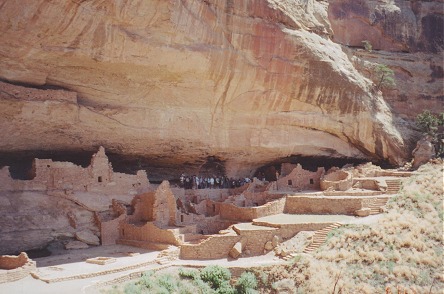
25/6/03 A morning ranger tour of another abandoned cave
dwelling and a short ride into Cortez. It's high season in this short summer
season town and hotel prices are high. Motorcycles are everywhere, the centre
of the USA, with people leaving the hot surrounding flatland states for the
cooler mountains. At first appearance you would think there was no recession
but our van park is filled with working class and poorer retirees. The National
Park campground was full of working families.
26/6/03 Four Corners, the only place where four states
meet, a popular stop over in this canyon, mountain region. We looped through
and onto Navaho lands to Kaytena. The Navajo are famous here not only for
ancient history but for coming up with an unbreakable code using their native
language. Deployed in the front lines in WW2, messages could be relayed quickly
over open radio lines using the code, they were the "Code Talkers". The region
of Monument Valley made famous for those cowboy and indian movie scenes of
boxed canyons and tall pinnacles rising from the desert's floor. Bright red
flat topped mesa each side of the road as we finish the loop back to Cortez.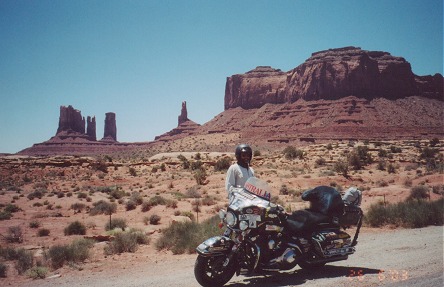
27/6/03 There seems to be a need to modify every natural
product in the USA as if nature wasn't good enough. Not just the latest
GM modified foods but it's almost impossible to find basic produce. The last
straw, meat, "may contain up to 12% solution," will last two weeks in the
refrigerated cabinet, has preservatives, salt, flavour enhancers and tenderizers.
Not speciality meat, the only available "fresh meat" at the Walmart Super
grocery store. Grapes, in small print, "may have been sprayed with preservative
to increase shelf life." Low fat yoghurt, corn starch thickened. Almost every
product has large amounts of salt, cheap and weighs heavily. These are added
after production. I wonder what chemicals, growth promotants, antibiotics
etc. are used in production. McDonalds recently took a major stance on its
meat, informing suppliers it would not be buying any meat where antibiotics
were used in the feed or where hormones or growth promotants were used, to
be phased in over the next two years. Hopefully the trend will swing back
to "real" foods. Travelled the magnificent mountain road from Cortez to Montrose,
snow still on the peaks, over a 3,000m pass with stunning scenery to camp
in Black Canyon NP. We bought the National Park pass, valid for one year,
giving free entry to all National Monuments and National parks and just $US50
for a car/motorcycle irrespective of the number of occupants. A great deal.
28/6/03 A rest day at Black Canyon, 2500m above sea level,
the air dry and the quiet almost solitude of the park appealing. There is
a policy of no showers at most National Parks in the USA. Water, cost conservation,
or a means to limit people's time in the parks. A few days without showers
or only a sponge bath is enough. It is cheaper for many retirees to N.P. hop
than to live in a house. With 50% discount for camping, thus usually $5-10
a night, many RV's (motorhome) across the country, meeting people, enjoying
the outdoors, moving with the seasons, catching up with family and friends
along the way. The 600m deep canyon, narrow vertical sides, appeals to rock
climbers and scramblers. We looked from the top viewpoints.
29/6/03 Dry desert canyon valleys to wet tree covered
mountains as we crossed another pass and back down to Wellington. The national
forests are used for all kinds of recreation. The hiking, fishing and swimming
variety plus horse riding and quad biking. People trailer their horses and
bikes into the forests to ride the trails, away from the noise and super
highways of cities.
30/6/03 We added just 140 miles to the 7 billion
miles Americans travel every day in automobiles (about a trip to the planet
Pluto and back). Through more scenic canyons to the hot Mormon city of Salt
Lake City. About 150 Mormons crossed from the east 160 years ago looking
for some land that no-one else would want. At first they were right, hot
and desolate they built their temple (church) and laid out a city, which
eventually became overrun by its own success.
1/7/03 The Temple Square, in the middle of the city, is
open to everyone. Missionaries from all over the world come here to help
the church and convert non believers. A guided tour, couple of films on the
church's short history and beliefs and a tour of their genealogy reference
section, the largest in the world. All services are provided free within
Temple Square, missionaries and staff are not paid. A seemingly young religion,
its prophet, Joseph Smith, living less than 200 years ago, yet the hard to
grasp concept of the Book of Mormons having been formulated in the Americas
2000 years prior, at the time of Jesus.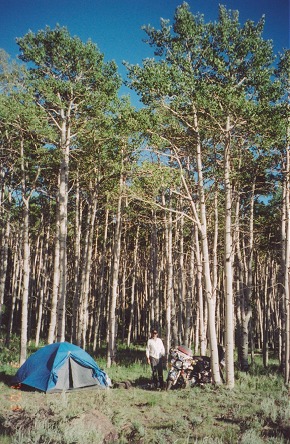
2/7/03 The salt lake, for the name of the city, is the
second saltiest in the world, after the Dead Sea. We rode and walked its
shoreline, seemingly undeveloped for any sporting activities. Visited the
Mormon Pioneer Museum, and amazing collection of memorabilia donated by the
close family oriented community. Items dragged across the plains in the 1840's,
magnificent lacework woven during long winters and photos of the town's officials.
3/7/03 Headed back south, more desert, more mountain forests.
Coming into the 4th of July weekend everyone of the hundreds of campground
spaces at Fish Lake in the National Forest was full. Motorhomes towing,
horses, boats or quad bikes crammed the spaces. We wild camped, allowed in
national forests, away from the road, shady spot away form the noise. Utah
and Colorado seem to be the "getaway" states, for valid reasons, beautiful
scenery combined with high altitude and cool summers.
4/7/03 Short trip to Capital Reef National Park. Surprisingly
empty this holiday weekend. A 100 mile fold in the earth's crust has created
desert canyons and deep winding river valleys amongst red rock walls. We
dropped below 2000m and the temperature rose to 35 centigrade, walked a watershed
canyon and learnt about the original inhabitants, Indians who left petroglyphs,
again great interpretive information in the National Parks.
5/7/03 An early morning walk, another canyon, one used
as a road early last century, pioneers drawing water from pools in a side
canyon now only used by the few hardy animals living in the desert. Squirrels,
birds and dragon flies come down to the tadpole filled pools to drink, as
we rested in the shade. The rest of the day hot and we did little but sit
in the shady campground.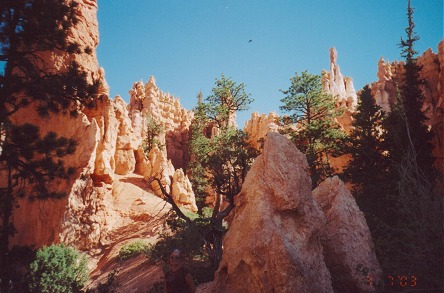
6/7/03 200 km along the scenic road 12 to Bryce Canyon.
Resupplied with food for the next two days, a hot shower, first in three
days, and a load of washing. Camping always takes a lot more time than motels
and restaurants. Quiet but busy our campground was full, as was the ranger
led talk on the park's geology.
7/7/03 We walked into the canyon between the white, pink
and apricot coloured hoodoo's (spires), towering above us, with hard rock
caps and eroded columns. Formed with sediment on a lake bottom 20 million
years ago, uplifted over two miles by earth movement and eroded by water
freezing and thawing all for the 1.5 million people who come here each year
to see. We try to walk a few km's each day for exercise and remember slogging
the pavement back home and compare it with the magnificent scenic walks,
we have done over the last couple of weeks, almost a reason to travel in
itself.
8/7/03 The popularity of Zion Canyon, 2.5 million visitors
a year, has led to the introduction of a shuttle bus system to its main
attractions. Propane gas powered they have reduced pollution in the valley
by 75%. Running every 6 minutes and pick up and drop off at many viewpoints
it allowed us to walk trails one way and shuttle back, something impossible
with your own vehicle. The enormous rock formations used to be massive sand
dunes, compacted and solidified, now eroded leaving sandstone mountains.
Water slowly permeates, 1000 years, through the stone, constantly feeding
rivers and hanging gardens under rocky overheads whilst surrounded by barren
desert.
9/7/03 Temperatures at our campsite have been over 108
degrees Fahrenheit (40 centigrade) each day making afternoons uncomfortable.
Today we took the "ranger talk" shuttle bus to the top of the canyon, walked
the mile long path and then walked up the canyon base for another two miles
crossing the river many times and walking in the cool waters. The canyon
walls gradually come closer shading the river and even at midday the air
is crisp. The later afternoon spent at the air-conditioned library avoiding
the worst of the heat.
Move with us to the next section of the U.S.A.
 4/6/03 We were at the Key West marina fuel dock by 7 am
and with a series of Agriculture, Immigration and Customs officials were
cleared by 9 am. The boat has a special permit to do mission work in Cuba
and as such the crew had no problems on returning to the USA. Being Australians
coming from Cuba we also were not subject to the US restrictions however had
we departed to Cuba from the USA and were now returning we would have been
subject to US laws regarding the embargo. We made a donation to the mission,
equal to what others had told us was the usual charge for the passage, and
said goodbye. The total cost for the crossing including Cuban paperwork being
about $US 400.00, no costs to enter the US. If you want to contribute to
the mission's work or find out more about what they do, the captain, Keith,
can be contacted by email on R5CaptainK@aol.com. A fork lift unloaded the
motorcycle from the boat's deck and we rode to the southernmost beacon in
the USA. It was 19 months ago when we left the beacon to do the loop through
Central, to South America and up the Caribbean, and great to return. Headed
up the coast to recover and regroup, at a cheap motel.
4/6/03 We were at the Key West marina fuel dock by 7 am
and with a series of Agriculture, Immigration and Customs officials were
cleared by 9 am. The boat has a special permit to do mission work in Cuba
and as such the crew had no problems on returning to the USA. Being Australians
coming from Cuba we also were not subject to the US restrictions however had
we departed to Cuba from the USA and were now returning we would have been
subject to US laws regarding the embargo. We made a donation to the mission,
equal to what others had told us was the usual charge for the passage, and
said goodbye. The total cost for the crossing including Cuban paperwork being
about $US 400.00, no costs to enter the US. If you want to contribute to
the mission's work or find out more about what they do, the captain, Keith,
can be contacted by email on R5CaptainK@aol.com. A fork lift unloaded the
motorcycle from the boat's deck and we rode to the southernmost beacon in
the USA. It was 19 months ago when we left the beacon to do the loop through
Central, to South America and up the Caribbean, and great to return. Headed
up the coast to recover and regroup, at a cheap motel.


 Being father's day and the traditional taking of dad to the ball game,
we went along to a new stadium bringing baseball back to inner cities. The
game seemed to take second fiddle to social activities with half the spectators
out of their seats at any one time, many down side-show alley, pitching, climbing,
rides, and the biggest event of all the feeding frenzy. I could not believe
the quantities of nachos, hot dogs, ice creams, coca cola, and the one use
packaging garbage generated by this pastime. The result of 4 to 3, Cubs to
Redbirds seemed of little interest, two home runs. Most excitement was generated
when the ball lobbed into the crowd, held aloft by the captor.
Being father's day and the traditional taking of dad to the ball game,
we went along to a new stadium bringing baseball back to inner cities. The
game seemed to take second fiddle to social activities with half the spectators
out of their seats at any one time, many down side-show alley, pitching, climbing,
rides, and the biggest event of all the feeding frenzy. I could not believe
the quantities of nachos, hot dogs, ice creams, coca cola, and the one use
packaging garbage generated by this pastime. The result of 4 to 3, Cubs to
Redbirds seemed of little interest, two home runs. Most excitement was generated
when the ball lobbed into the crowd, held aloft by the captor. 




